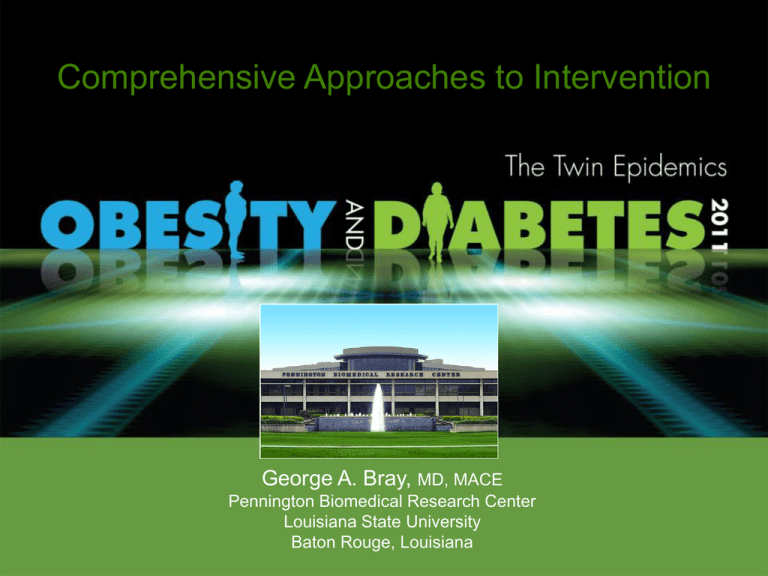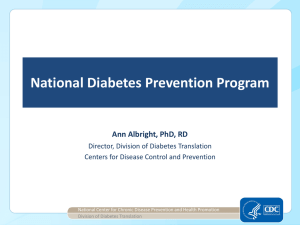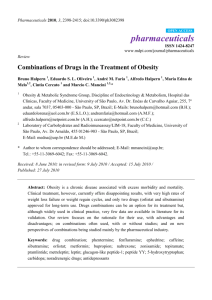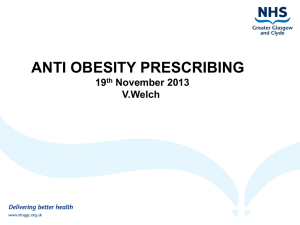Obesity - Medscape
advertisement

Comprehensive Approaches to Intervention George A. Bray, MD, MACE Pennington Biomedical Research Center Louisiana State University Baton Rouge, Louisiana Key Points • Weight loss is beneficial • Several strategies will produce weight loss – Lifestyle changes – Diet – Exercise – Pharmacotherapy • Summary 2 BMI Has Biggest Effect on Diabetes Men Women 6 6 5 5 4 4 3 3 2 2 1 1 0 <21 22 23 24 25 26 27 28 29 30 0 <21 22 23 24 25 26 27 28 29 30 BMI (kg/m2) BMI (kg/m2) Type 2 diabetes Cholelithiasis BMI, body mass index. Willett WC et al. N Engl J Med. 1999;341(6):427–434. Hypertension Coronary heart disease 3 Small Weight Loss Reduces Risk of Diabetes in the DPP Weight Change in DPP (kg) Placebo Reduces Risk of Diabetes by 58% Lifestyle 0 6 12 18 24 30 36 42 48 Months in Study DPP, Diabetes Prevention Program. Knowler WC et al. N Engl J Med. 2002;346(6):393–403. 4 How Much Weight Loss Is Needed to Prevent Type 2 Diabetes? Incidence Rate per 100 Person-Years 20 15 10 5 0 -10 -5 0 +5 Change in Weight From Baseline (kg) Redrawn from: Hamman RF et al. Diabetes Care. 2006;29(9):2102–2107. 5 Key Points • Weight loss is beneficial • Several strategies will produce weight loss – Lifestyle changes – Diet – Exercise – Pharmacotherapy • Summary 6 Components of Behavior Therapy for Obesity Selfmonitoring Problem solving Cognitive restructuring Contingency management Social support Stimulus control Stress management Wadden TA, Foster GD. Med Clin North Am. 2000:84(2):441–461. 7 Weight Change From Baseline (%) 4-Year Weight Loss in the Look AHEAD Trial DSE ILI Year Repeated measures adjusted for clinic and baseline level. P value for average effect across all visits: P < 0.0001. DSE, diabetes support and education; ILI , intensive lifestyle intervention. 8 Look AHEAD Research Group, Wing RR. Arch Intern Med. 2010;170(17):1566–1575. Lifestyle Intervention Was Clinically Effective in All Subsets of an Ethnically and Demographically Diverse Population Reduction (%) in Initial Weight in ILI Participants 0.0 African American Hispanic Other/ Mixed 2.0 4.0 NonHispanic White Male Female 6.0 8.0 10.0 12.0 Wadden TA et al. Obesity (Silver Spring). 2009;17(4):713–722. 9 Correlates of Weight Loss: Look AHEAD Rank Order of Importance 1. Self-reported physical activity 2. Diet and physical activity counseling sessions attended 3. Consumption of meal replacements • At 1 year, ILI participants lost more weight if: – Attended more treatment sessions – Exercised more – Consumed more meal replacement products 10 Key Points • Weight loss is beneficial • Several strategies will produce weight loss – Lifestyle changes – Diet – Exercise – Pharmacotherapy • Summary 11 ARS: Which intervention was most effective in reducing the risk of diabetes among those at risk in the DPP? 1. Diet and exercise 2. Metformin 12 DPP Results: 3.2-Year Progression from IGT to T2DM 58% reduction IGT, impaired glucose tolerance; T2DM, type 2 diabetes mellitus. Knowler WC et al. N Engl J Med. 2002;346(6):393–403. 14 ARS: A reduced-calorie diet emphasizing which of the following is associated with the greatest weight loss? 1. Carbohydrate 2. Fat 3. Protein 4. No difference 15 POUNDS LOST: Weight Loss (ITT) Diet Composition Carbohydrate/Protein/Fat 0 –1 65/15/20 55/25/20 45/15/40 35/25/40 Weight Loss (kg) –2 –3 –4 –5 –6 –7 0 6 12 18 24 Months ITT, intent to treat. Sacks FM et al. N Engl J Med. 2009;360(9):859–873. 17 POUNDS LOST: Weight Change and Attendance: High Protein, High Fat 30 Weight Change (kg) 20 10 0 –10 –20 –30 –40 –50 0 10 20 30 40 N = 168 Number of Sessions Attended Slope = –0.217 P < 0.001 Sacks FM et al. N Engl J Med. 2008;360(9):859–873. 50 60 18 Dietary Components That Predict 4-Year Changes in Body Weight Weight effects, lb Whole grains Vegetables Fruits Nuts Yogurt Fried foods home Trans fat Processed meats Red meats Sugared beverage Potato fries Potato chips Mozafferian D et al. N Engl J Med. 2011;364(25):2392–2404. 19 Key Points • Weight loss is beneficial • Several strategies will produce weight loss – Lifestyle changes – Diet – Exercise – Pharmacotherapy • Summary 20 Effect of Exercise on Initial Rate of Weight Loss and on Subsequent Weight Status Non-Exercise 8 Exercise Treatment (weeks) Pavlou KN et al. Am J Clin Nutr. 1989;49(5 suppl):1110–1114. 18 Follow-up (months) 21 High Activity Needed for Weight Loss Maintenance P Values Group effect <0.001 Time effect <0.001 Group X time effect <0.02 –2 –4 –6 Change in Weight (kg) Percent Weight Loss (%) 0 –8 –10 –12 –14 –16 0 6 12 18 24 Months <150 min/wk (N = 86) 250–299 min/wk (N = 21) 150–249 min/wk (N = 19) ≥300 min/wk (N = 44) *P<0.05. Jakicic JM et al. Arch Intern Med. 2008;168(14):1550–1560. 22 Key Points • Weight loss is beneficial • Several strategies will produce weight loss – Lifestyle changes – Diet – Exercise – Pharmacotherapy • Summary 23 Pharmacotherapy • For obesity without comorbidities • For obesity with diabetes mellitus • Drugs in limbo 24 Drugs Approved by the FDA for Treatment of Obesity • Sympathomimetics – Diethylpropion (DEA Schedule IV) – Phentermine (DEA Schedule IV) – Benzphetamine (DEA Schedule III) – Phendimetrazine (DEA Schedule III) • Orlistat FDA, Food and Drug Administration; DEA, Drug Enforcement Administration . 25 Effect of Long-term Treatment With Orlistat (The XENDOS Study) Change in Body Weight (kg) 0 –3 Placebo + Lifestyle P<0.001 –6 Orlistat + Lifestyle –9 –12 0 52 104 156 208 Weeks of Treatment Torgerson JS et al. Diabetes Care. 2004;27(1):155–161. 26 Pharmacotherapy • For obesity without comorbidities • For obesity with diabetes mellitus • Drugs in limbo 27 ARS: Which of the following classes of drugs for patients with diabetes is associated with weight loss? 1. DPP-4 inhibitors 2. GLP-1 agonists 3. Insulin 4. Sulfonylureas 5. Thiazolidinediones DPP-4, dipeptidyl peptidase-4; GLP-1, glucagon-like peptide-1. 28 Slide Unavailable Bray, Circulation in press 30 DPP: Metformin and Lifestyle Over Time 2 Change in Weight (kg) 0 –2 –4 Placebo Metformin –6 Lifestyle –8 0 1 2 3 4 5 6 7 8 9 10 Year Since DPP Randomization DPP Research Group. Lancet. 2009;374(9702):1677–1686. 31 Pramlintide Produced Weight Loss: % Change in Weight (ITT Populations, Observed Data) BID Regimen TID Regimen Evaluable 1 Double-blind study ITT-LOCF Evaluable 1 Single-blind extension ITT-LOCF Single-blind extension 0 -1 -2 -3 -4 -5 -6 * * -7 -8 ** -9 -10 Mean (±SE) Change in Body Weight (kg) Mean (±SE) Change in Body Weight (kg) 0 Double-blind study -1 -2 -3 -4 -5 * -6 * * ** ** ** * ** -7 -8 -9 -10 -11 -11 0 Number of Subjects Placebo 36 120 µg BID 38 240 µg BID 32 360 µg BID 39 4 36 38 32 39 Placebo Time (mo) 17 24 17 21 8 17 25 16 21 120 µg Pramlintide 12 17 24 17 21 12 27 28 25 32 0 Number of Subjects Placebo 36 120 µg BID 38 240 µg BID 45 360 µg BID 42 4 36 38 45 42 240 µg Pramlintide *P < 0.05 and **P < 0.01 for each pramlintide treatment group versus placebo. Smith SR et al. Diabetes Care. 2008;31(9):1816–1823. Time (mo) 17 25 23 18 8 12 12 17 25 23 18 17 25 23 17 27 29 30 38 360 µg Pramlintide 32 Combination of Pramlintide and Phentermine on Body Weight 0 Weight Loss (kg) Placebo Pramlintide –5 –10 Pram + Phen –15 0 10 20 30 Weeks of Treatment Aronne L et al. Obesity (Silver Spring). 2010;18(9):1739–1746. 33 Exenatide:* An Anti-diabetic Drug That Produces Weight Loss Change in body weight (kg) 0.5 0 -0.3 ± 0.3 kg -0.5 ** -1.0 ** -1.5 -1.6 ± 0.4 kg † ** -2.0 -2.5 † Placebo 5 g Exenatide 10 g Exenatide -3.0 -3.5 -2.8 ± 0.5 kg † † † -4.0 0 5 10 15 Weeks *Not approved for treatment of obesity **P≤.05 vs placebo; †P≤.001 vs placebo. Defronzo RA, et al. Diabetes Care. 2005;28:1092-1100. 20 25 30 Liraglutide,* an Antidiabetic Drug, and Orlistat Produce Weight Loss 0 Placebo 1.2 mg/day –4 –6 1.8 mg/day Randomization Screening Weight Loss (kg) –2 2.4 mg/day 3.0 mg/day Orlistat –8 –10 –5 0 5 10 15 20 Weeks From Randomization *Not approved for treatment of obesity. Astrup A et al. Lancet. 2009;374(9701):1606–1616. 35 Pharmacotherapy • For obesity without comorbidities • For obesity with diabetes mellitus • Drugs in limbo – Topiramate/phentermine – Bupropion/naltrexone – Lorcaserin 36 Topiramate/Phentermine* Produces Weight Loss (Completers) 0 Weight change (kg) -2 -4 * -6 * Placebo Phentermine 7.5 mg plus topiramate 46.0 mg Phentermine 15.0 mg plus topiramate 92.0 mg * * -8 * * * * * * * 16 24 32 40 Weeks of Treatment 48 56 851 437 744 403 670 387 623 369 589 356 573 350 557 338 843 775 747 712 686 660 625 * -10 * * -12 -14 0 Study completers Placebo 979 Phentermine 7.5 mg plus 488 topiramate 46.0 mg Phentermine 15.0 mg plus 981 topiramate 92.0 mg 8 *Investigational Gadde KM et al. Lancet. 2011;377(9774):1341–1352. 37 Naltrexone-Bupropion* Produces Weight Loss (Completers) Weight Change from Baseline (kg) 0 Placebo N = 507 –2 –4 –6 NB 16 mg (N = 467) –8 NB 32 mg (N = 467) –10 0 8 16 24 32 40 48 56 Bupropion 360 mg/day Dropouts ̴ 50% Weeks of Treatment *Investigational Greenway FL et al. Lancet. 2010;376(9741):595–605. 38 Lorcaserin* Produces Weight Loss (Completers) 0 Weight Loss (kg) –2 –4 Placebo Crossover –6 Continuous –8 –10 –12 0 8 16 24 32 40 48 56 64 72 80 88 96 104 Weeks of Treatment *Investigational Placebo N = 684 Crossover N = 275 Continuous N = 564 Smith SR et al. N Engl J Med. 2010; 363(3):245–256. 39 Key Points • Weight loss is beneficial • Several strategies will produce weight loss – Lifestyle changes – Diet – Exercise – Pharmacotherapy • Summary 40 Summary and Recapitulation • Weight loss is beneficial, particularly if disease risk is present • Several strategies will produce weight loss – Lifestyle changes/diet/exercise – Pharmacotherapy – Surgery • Summary 41 2010 Was A Momentous & Disappointing Year for Obesity With 5 FDA Panels • July 15, 2010 – Combination of topiramate/ phentermine reviewed by FDA - 10 for 6 against • Sept 15, 2010 – Continued marketing of sibutramine in light of SCOUT study was reviewed by FDA panel - 8 for and 8 against continued marketing • Sept 16, 2010 – Lorcaserin new drug application reviewed by FDA Panel – 9 for and 5 against • Oct 8, 2010 – Sibutramine withdrawn • Dec 7, 2011 – BMI lowered for some surgical operations • Dec 15, 2010 – Combination of buproprion/ naltrexone recommended 13/7 for approval. FDA is requiring an outcomes trial before approval Unintended Consequences of Drug Treatment for Obesity in the 20th Century Year Drug Consequence 1892 Thyroid Hyperthyroidism 1932 Dintrophenol Cataracts/Neuropathy 1937 Amphetamine Addiction 1968 Aminorex Pulmonary Hypertension 1997 Phen/Fenfluramine Valvulopathy 1998 Phenylpropanolamine Strokes 2003 Ma Huang (ephedra) Heart attacks/stroke 2007 Ecopipam (Dopamine) Depression/Suicide 2008 Rimonabant (CB-1) Depression 2010 Sibutramine CVD Risk Bray GA Battle of the Bulge, Dorrance Publishing 2007 p. 59 Lesson for Today • “A desire to take medicine is, perhaps, the great feature which distinguishes man from other animals” Osler W. Science 1891;17:170-171











